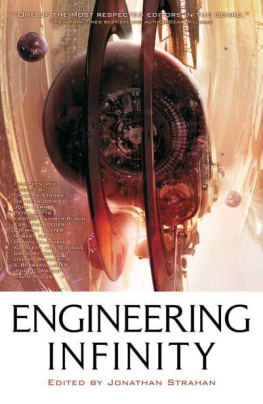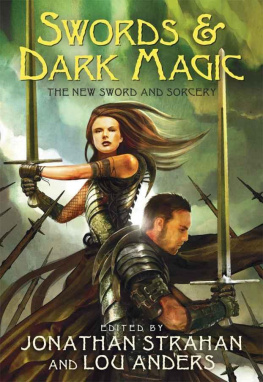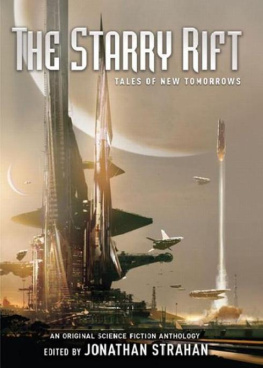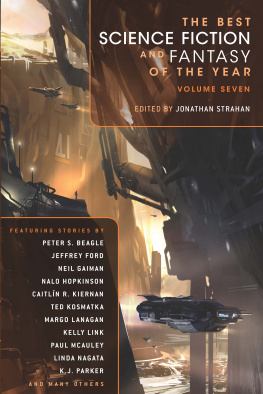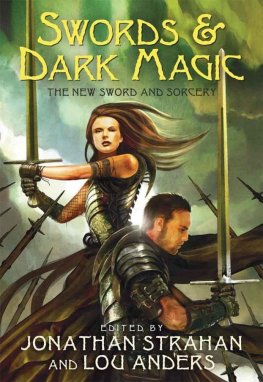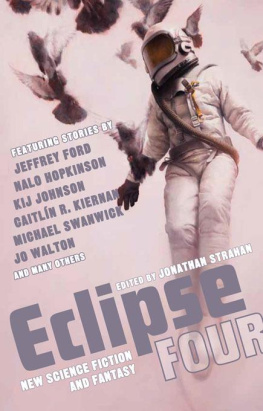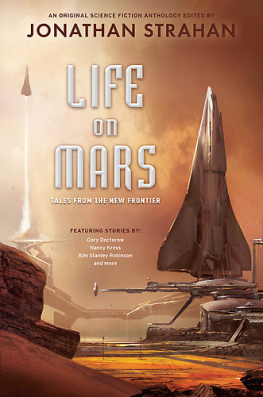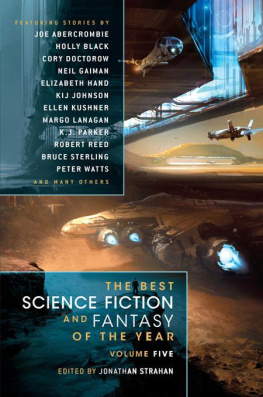Jonathan Strahan - Engineering Infinity
Here you can read online Jonathan Strahan - Engineering Infinity full text of the book (entire story) in english for free. Download pdf and epub, get meaning, cover and reviews about this ebook. year: 2011, publisher: Solaris, genre: Science. Description of the work, (preface) as well as reviews are available. Best literature library LitArk.com created for fans of good reading and offers a wide selection of genres:
Romance novel
Science fiction
Adventure
Detective
Science
History
Home and family
Prose
Art
Politics
Computer
Non-fiction
Religion
Business
Children
Humor
Choose a favorite category and find really read worthwhile books. Enjoy immersion in the world of imagination, feel the emotions of the characters or learn something new for yourself, make an fascinating discovery.
- Book:Engineering Infinity
- Author:
- Publisher:Solaris
- Genre:
- Year:2011
- Rating:4 / 5
- Favourites:Add to favourites
- Your mark:
- 80
- 1
- 2
- 3
- 4
- 5
Engineering Infinity: summary, description and annotation
We offer to read an annotation, description, summary or preface (depends on what the author of the book "Engineering Infinity" wrote himself). If you haven't found the necessary information about the book — write in the comments, we will try to find it.
Engineering Infinity — read online for free the complete book (whole text) full work
Below is the text of the book, divided by pages. System saving the place of the last page read, allows you to conveniently read the book "Engineering Infinity" online for free, without having to search again every time where you left off. Put a bookmark, and you can go to the page where you finished reading at any time.
Font size:
Interval:
Bookmark:

Engineering Infinity
Edited by Jonathan Strahan
Including stories by
Charles Stross
Gwyneth Jones
John Barnes
Peter Watts
Kristine Kathryn Rusch
Karl Schroeder
Stephen Baxter
Robert Reed
Hannu Rajaniemi
Kathleen Ann Goonan
Gregory Benford
Damien Broderick & Barbara Lamar
John C. Wright
David Moles
In memory of Charles N. Brown and Robert A. Heinlein, two giants of our field who each in his own way inspired my love for science fiction.
First published 2010 by Solaris, an imprint of Rebellion Publishing Ltd, Riverside House, Osney Mead, Oxford, OX1 0ES, UK
www.solarisbooks.com
ISBN(.mobi): 978-1-84997-235-2
ISBN(.epub): 978-1-84997-236-9
Introduction and story notes and arrangement
copyright 2011 Jonathan Strahan.
"Malak" copyright 2011 Peter Watts.
"Watching the Music Dance" copyright 2011 Kristine Kathryn Rusch.
"Laika's Ghost" copyright 2011 Karl Schroeder.
"The Invasion of Venus" copyright 2011 Stephen Baxter.
"The Server and the Dragon" copyright 2011 Hannu Rajaniemi.
"Bit Rot" copyright 2011 Charles Stross.
"Creatures with Wings" copyright 2011 Kathleen Ann Goonan.
"Walls of Flesh, Bars of Bone" copyright 2011
Damien Broderick & Barbara Lamar.
"Mantis" copyright 2011 Robert Reed.
"Judgement Eve" copyright 2011 John C. Wright.
"A Soldier of the City" copyright 2011 David Moles.
"Mercies" copyright 2011 Abbenford Associates.
"The Ki-anna" copyright 2011 Gwyneth Jones.
"The Birds and the Bees and the Gasoline Trees" copyright 2011 John Barnes.
The right of the author to be identified as the author of this work has been asserted in accordance with the Copyright, Designs and Patents Act 1988.
All rights reserved. No part of this publication may be reproduced, stored in a retrieval system, or transmitted, in any form or by any means, electronic, mechanical, photocopying, recording or otherwise, without the prior permission of the copyright owners.
A CIP catalogue record for this book is available from the British Library.
Designed & typeset by Rebellion Publishing
Acknowledgements
An anthology is not assembled by one person, neatly and tidily, working in idyllic isolation (at least, not in my experience). Rather it's the incredibly fortunate outcome of the efforts of a small village of talented and extremely generous people.
Engineering Infinity would not exist without the efforts of Jonathan Oliver and the remarkable team at Solaris, my indefatigable agent Howard Morhaim and his assistant Katie Menick, and the wonderful Stephan Martiniere who has done another remarkable cover - I am grateful to them all. I am also grateful to each and every one of the book's contributors who have been far kinder and more patient than I had any right to hope.
Finally, as always, I would like to thank my wife Marianne and my daughters Jessica and Sophie, who allow me to steal time from them to do books like this one. It's a gift I try to repay every day.
Introduction
Beyond the Gernsback Continuum...
Jonathan Strahan
I was in a bar. I think it was in Calgary in Canada. And it was the middle of winter. Or it might have been the bar in Denver in the United States, a little earlier in the same winter. Wherever it was, it was the winter of 2008 somewhere in North America and George Mann and the Solaris team had asked me to join them for a drink. I don't drink often and I don't drink heavily, but I do drink at science fiction conventions, especially when publishers have invited me to join them. It seemed that Solaris would like me to edit an anthology, a hard science fiction anthology or something similar, the book that has become the one you now hold in your hands: Engineering Infinity . I was flattered, delighted in fact, and given that I had some experience editing such stuff, I agreed readily to the idea.
At the time, and in the several months following that trip to Canada (it was Canada, I'm sure) we went back and forth a little about titles and about which writers might be involved, but oddly, in retrospect, what we didn't discuss was what hard science fiction was, or what it might be in the 21st Century. The reason for that, I think, is what I now think of as the "Gernsback continuum." Science fiction readers love taxonomy - classifying, arranging and defining things - and what we love to taxonomise the most is science fiction itself. The Gernsback continuum is the slice of science fiction history that starts with Hugo Gernsback's Amazing Stories , progresses to John W. Campbell's Astounding Magazine and the Big Three of Science Fiction (Robert Heinlein, Isaac Asimov and Arthur C. Clarke), and then on to the New Wave and its descendants). It's a mostly male worldview, a mostly white one, and it holds at its heart "hard SF."
The term "hard SF" or "hard science fiction" was first coined in 1957 by P. Schuyler Miller to describe science fiction stories that emphasize scientific detail or technical detail, and where the story itself turns on a point of scientific accuracy from the fields of physics, chemistry, biology, or astronomy, although engineering stories were also commonly described as hard science fiction in the early days of SF. The great early works of hard science fiction - James Blish's Surface Tension , Hal Clements' Mission of Gravity , Tom Godwin's "The Cold Equations," and Arthur C. Clarke's A Fall of Moondust - are some of the best and most enduring works of science fiction our field has seen. They all exemplify the hard SF approach: emphasizing science content, linking it directly to the narrative, and maintaining a rigorous approach to the science itself. They also meet the most important requirement for the true hard SF story: they all are as accurate and rigorous in their use of scientific knowledge at the time of writing as was possible.
Hard science fiction has remained a constant throughout the history of science fiction. In the 1950s it was where the best tales of space exploration were forged; in the 1960s it was the heart of near-Earth science fiction; in the 1980s it was the radical centre for the British drive to the new space opera; and in the 1990s, with the arrival of both quantum mechanics in science fiction and the singularity, it was the basis for Kim Stanley Robinson's meticulous and demanding Mars trilogy, Greg Egan's explorations of human consciousness, and Charles Stross's post-scarcity space operas.
This, however, is the 21st century and I think things are becoming more complicated and complex. Science fiction no longer subscribes readily to a single view of its own history. There's far more to our past than the Gernsback continuum, or indeed more recently the Gibson continuum (the past and future history of cyberpunk), and science itself seems to be an ever more wriggly and complex beast as we come to better understand the universe in which we find ourselves. Frankly quantum mechanics often sounds indistinguishable from magic. We're also well into the Fourth Generation of science fiction: the genre has been born, passed through adolescence, into adulthood, and is moving into a post-scarcity period of incredible richness and diversity. That impacts on everything in our field, from the diversity of the people who write science fiction to whom and about what they choose to write. We've also long since accepted that science fiction writers aren't back-room nostrodamusses reading tealeaves and predicting the future. They're people using science fiction as a tool to interrogate and extrapolate from our present for what we can learn about the human condition.
Font size:
Interval:
Bookmark:
Similar books «Engineering Infinity»
Look at similar books to Engineering Infinity. We have selected literature similar in name and meaning in the hope of providing readers with more options to find new, interesting, not yet read works.
Discussion, reviews of the book Engineering Infinity and just readers' own opinions. Leave your comments, write what you think about the work, its meaning or the main characters. Specify what exactly you liked and what you didn't like, and why you think so.

